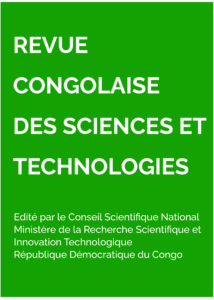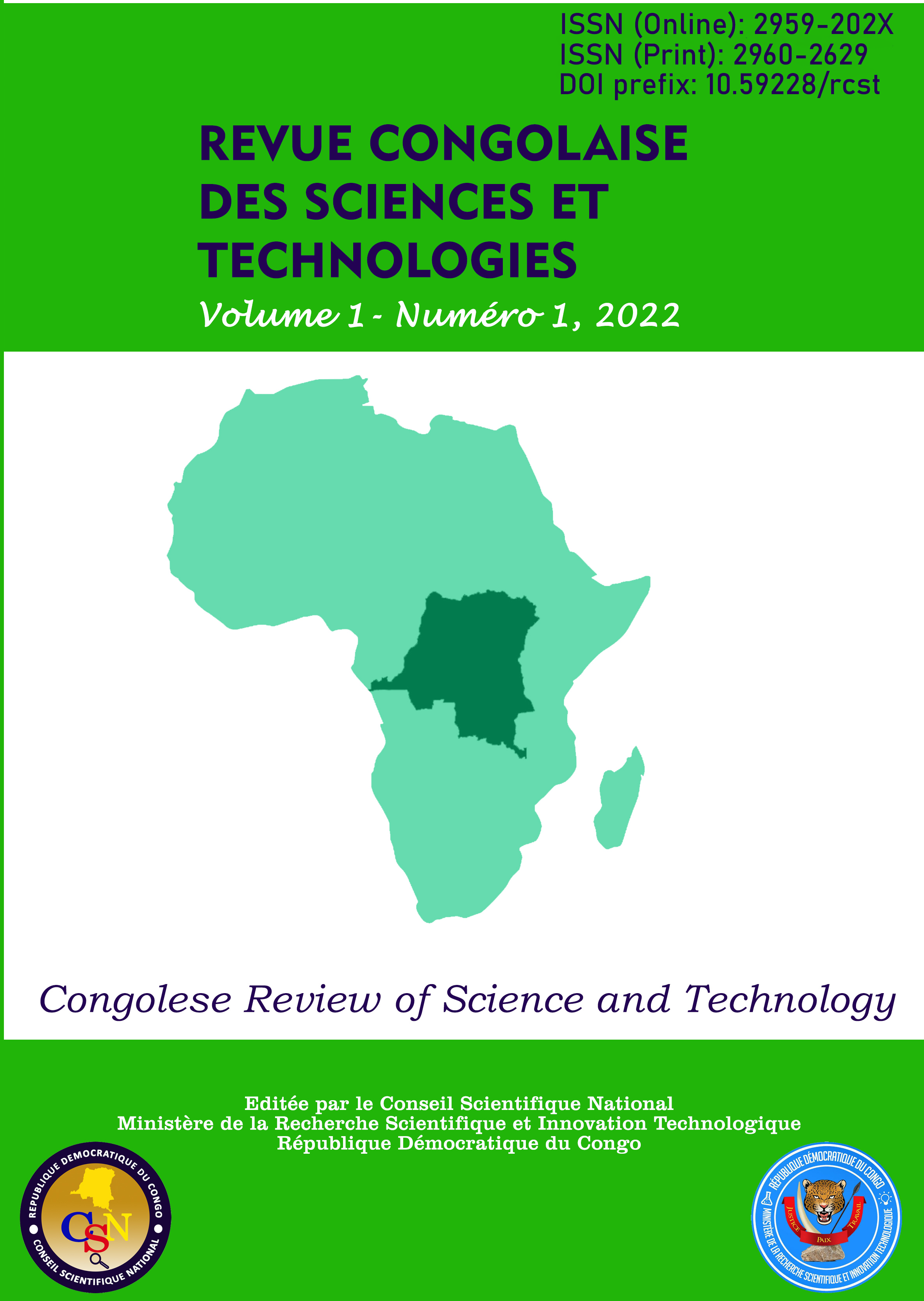Contribution of the International Committee of the Red Cross to Peace in the Eastern Province in Democratic Republic of the Congo: Study undertaken from 2003 to 2009
Main Article Content
Abstract
Being an impartial, neutral and independent organization not-governmental international, the International Committee of the Red Cross has the role of protecting the life and dignity from the victims of the war and internal violence, to bring the assistance to them. The Eastern Province in Democratic Republic of Congo profits from it enormously, because of the active presence of this Committee which intervenes and prevents the suffering by the reinforcement of the principles of humanity and the right. And it is in time of hostilities in period of war and post-conflict that this intervention is more visible and remarkable and that, more on the side of the victims of the human atrocities. On this, our problem is articulated around one principal question: Which are the causes and the consequences of the wars having prevailed in the Eastern Province, which required the intervention of the International Committee of the Red Cross? The objectives in this study are to identify the actions carried out by the International Committee of the Red Cross, so that in the event of non-effectiveness of its intervention, this last can cure its weaknesses in the future. To reach the explanation, we chose the systemic analysis by inputs of which requests and declarations of the population victim; the outputs of which answers and solutions brought to the victims by the urgent qualified ones; limps black made up of authorities of decision-making of the International Committee of the Red Cross; and by the feedback having milked with the attitude of the population either by satisfaction, or by statutes-quo, or by the refusal towards the solutions brought to their request. Through this study, we affirm that the International Committee of the Red Cross had contributed for peace by the actions of humane interference, such as medical care, drinking waters, rehabilitation, repatriation, re-establishment, cleansing and supply of the rural centers of health and other materials. In any sum, the International Committee of the Red Cross, in spite of its contribution for the support with peace, the total pacification of its civil populations, since the Democratic Republic of Congo east one of the States signatories adhering to the Charter of the Organization of the United Nations. The peace returns in first line to the Member States of the United Nations and signatories of conventions and additional protocols of Geneva.
Article Details

This work is licensed under a Creative Commons Attribution-NonCommercial-ShareAlike 4.0 International License.
References
Amis de Nelson Mandela pour la défense des droits humains (2000). Guerre à Kisangani, mois de juin, p.3.
Bana Api (2003). Le conflit en Ituri: une lecture commune par les intellectuels Hema et Lendu originaires de l’Ituri à Kisangani, mois de janvier, p. 5.
Boudon R. & Fillieule R. (2012). Les méthodes en Sociologie, 13ème édition, PUF, Paris, p. 43.
Cabanis A., Crouzartier J.M., Ivan R. & Soppelsa J. (2010). Méthodologie de la recherche en droit international, géopolitique et relations internationales, Agence Universitaire de la Francophonie, p. 56.
CICR (2005). bulletin spécial, Kisangani, mois d’Avril et de Mai.
CICR (2002). bulletin spécial, Kisangani, mois d’Août.
CICR (2003). bulletin spécial, Kisangani, mois de janvier.
CICR (2007). Activités en Province Orientale, dernière mise à jour, mois de décembre.
Codes Larciers (2009). RDC, tome VI, droit public et administratif, volume I, p.p. 1512
Conflit Hema-Bale (1999). Territoire de Djugu : mémorandum de la chrétienté Bale face à la guerre tribale, adressée au Saint Père, le Pape Jean Paul II, Mola, Décembre, p. 114
Conseil de Sécurité des Nations-Unies (2003). “Abdendum to the report panel of esperts on the illegal exploitation of natural ressources and forms of wealth of the Democratic Republic of Congo,” in Human Right Watch, p. 13.
Corten O. (2009). Méthodologie du droit international public, 8ème édition de l’ULB, Bruxelles, p. 37.
Dallier P., Pellet A. & Nigeyen Q.D. (2008). Droit international public, 8ème édition LGDJ, Paris, p. 12.
Decaux E. (2006). Droit International public, 6ème édition Dalloz, Paris, p. 20.
Découvrez le CICR (2005). Secteur production, édition CICR, Genève, mois de Septembre, p. 5.
FARDC (2009), instruments essentiels du droit international humanitaire et des droits de l’homme, p.p. 1, 12
Groupe Lotus (2000). Les affrontements de juin 2000 entre troupes Rwandaises et Ougandaises à Kisangani, Nord-Est de la RDC: des graves violences de droit international humanitaire », p.p. 6, 9, 12.
Héritage Oil Press (2003). Héritage confirms Uganda Oil potential and outlines futher investment planes, mois de mars.
Honigman J. (1985). Ethnies et espaces : pour une anthropologie topologique. In : Amselle J. et Elikia Mbokolo, au coeur de l’ethnie ; ethnie et tribalisme et l’Etat en Afrique, édition la découverte, Paris, p. 18.
https://www.afriquequestion.com/ (consulté le 13 Août 2018 à 11 heures).
Human Right Watch (2003). Ituri couvert de sang, violence ciblée sur certaines ethnies dans le Nord- Est de la RDC, volume 15, n°11 (A), mois de juillet p.p. 1, 13, 15.
Mosengwo Pasinya (2003). Discours d’ouverture de la conférence de l’ASSEP/ Kisangani, tenue à Naïrobi du 21 au 25 janvier.
Kadiebwe M.R. (2009). Affrontements armés des contingents Rwando- Ougandais dans la ville de Kisangani, L’Harmattan, Paris, p. 13.
Lobho D. (1991). Influence du régime foncier coutumier sur l’organisation socio- politique des collectivités locales chez les Bahema et les Walendu du territoire de Djugu. In : Zaïre Afrique, n°80, décembre p.p. 565, 566.
Mercier P. (1961). Remarques sur la signification du tribalisme actuel en Afrique noire. In : cahiers internationaux de sociologie, volume XXI, juillet décembre, p. 65.
Mulumbati Ngasha A. (2006). Introduction à la science politique, 2ème édition revue et mise à jour, édition Africa, Lubumbashi, p. 20
Rapport du CICR (2007). Activités à Kisangani et ses environs, mois de décembre.
Rapport Hema- Lendu (1999). Bunia, du 29 juillet au 04 octobre, p. 7.
Tibamwenda A. (2008). Ethnicité et ses effets pervers sur la paix, communauté au séminaire, atelier sur l’analyse et la transformation des conflits, Kisangani, p. 11.

